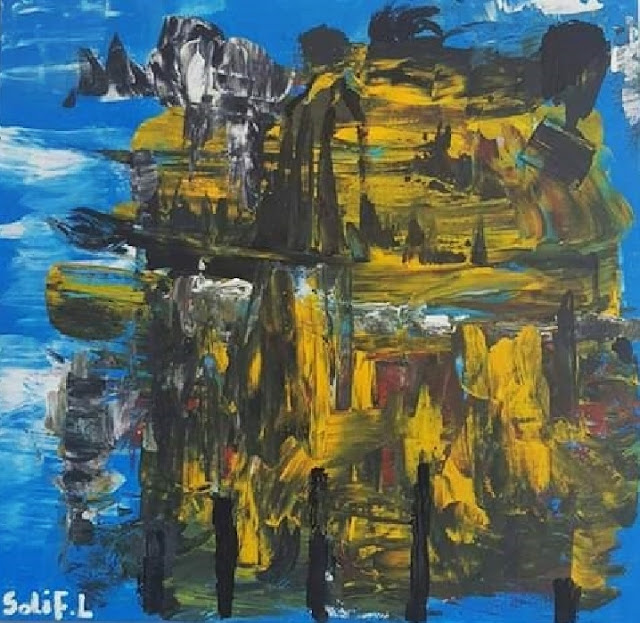Burkina Faso

Painting is like silent poem, said Simonides, poet from ancient Greece.Paintings are icons, doors to the Platonian world above the heavens. Paintings on my blog are just those icons, which lead a viewer into the magic world of harmony and beauty. Artists who present their achievements on my blog have a very different cultural and national background, they represent variety of artistic traditions and schools
Mathias Goeritz - Abstract Sculpture
"Mathias Goeritz was a German-born Mexican sculptor. He is best known for his interest in what he called “emotional architecture,” which was a belief in objects that elicited an emotional response rather than objects purely for functionality. Goeritz’s public sculptures were often large-scale and inspired by prehistoric cave paintings and monoliths. Born on April 4, 1915 in Danzig, Germany (now Gdansk, Poland), the artist grew up in Berlin. He went on to study philosophy and the history of art at the Friedrich-Wilhelms-Universität in Bonn, while also studying art under Max Kaus and Hans Orlowski at the Berlin-Charlottenberg School of Arts and Crafts. Goeritz left Germany in 1941 to escape World War II, first settling in Morocco, then Spain, and then in Mexico, where he worked as a teacher. During the 1950s, the artist worked with the architect Luis Barragán to produce massive, abstract concrete sculptures, and Goeritz first presented his “Manifiesto de la Arquitectura Emocional” (“Emotional Architecture Manifesto”). Goeritz’s works are in the collections of The Museum of Modern Art in New York and the Carnegie Museum of Art in Pittsburgh, among others. He died on August 4, 1990 in Mexico City, Mexico."(artnet)
Alberto Carneiro - Conceptualism - Ecological Art
Alberto Carneiro ( 20 September 1937 – Porto, 15 April 2017) was a Portuguese artist.
Born in Coronado, Minho in 1937. Between 1947 and 1958 works in religious art workshops of their land, starting on the technologies of wood, stone and ivory. He attended high school in Decorative Arts School Soares dos Reis, Porto, and Secondary School Antonio Arroyo, Lisbon.
In London he makes contact with the newly emerging artistic trends at the end of the 1960s, notably with the minimal and British Conceptual Art. From there develops innovative projects for the Portuguese context, including The cane field: metamorphosis memory of an absent body (1968) and A forest to your dreams (1970), which approaches the Land Art, revealing a special attention to the values of an art of 'involvement', which leaves the primacy of manual labor to consider the conceptual design, a progressive dematerialization of the artwork. This anthropological vision of artistic creativity is combined with an approach to the Eastern philosophies of the essence and nature (Zen Buddhism, Tantra) and take you to draw up the 'Manifesto of Ecological Art' '(1968-72) that rejects the Western dualism sensuality / spirituality and promotes the rehabilitation of the easiest things in the mean of aesthetic communication .
In 1977 participates in the exhibition 'Alternativa Zero'.
'In addition to his art, it should be noted his numerous writings that are a key contribution to the understanding of one of the most radically genuine works of Portuguese contemporary art, where nature, art and body come together simultaneously in a universal discourse and personal ."Wikipedia
Born in Coronado, Minho in 1937. Between 1947 and 1958 works in religious art workshops of their land, starting on the technologies of wood, stone and ivory. He attended high school in Decorative Arts School Soares dos Reis, Porto, and Secondary School Antonio Arroyo, Lisbon.
In London he makes contact with the newly emerging artistic trends at the end of the 1960s, notably with the minimal and British Conceptual Art. From there develops innovative projects for the Portuguese context, including The cane field: metamorphosis memory of an absent body (1968) and A forest to your dreams (1970), which approaches the Land Art, revealing a special attention to the values of an art of 'involvement', which leaves the primacy of manual labor to consider the conceptual design, a progressive dematerialization of the artwork. This anthropological vision of artistic creativity is combined with an approach to the Eastern philosophies of the essence and nature (Zen Buddhism, Tantra) and take you to draw up the 'Manifesto of Ecological Art' '(1968-72) that rejects the Western dualism sensuality / spirituality and promotes the rehabilitation of the easiest things in the mean of aesthetic communication .
In 1977 participates in the exhibition 'Alternativa Zero'.
'In addition to his art, it should be noted his numerous writings that are a key contribution to the understanding of one of the most radically genuine works of Portuguese contemporary art, where nature, art and body come together simultaneously in a universal discourse and personal ."Wikipedia
Subscribe to:
Comments (Atom)

























































